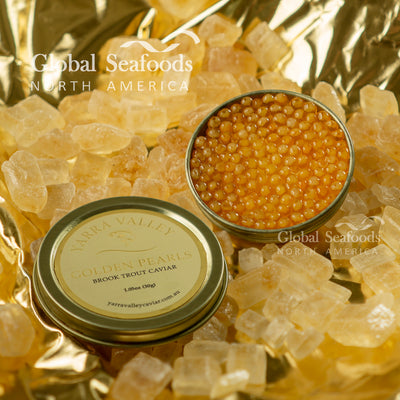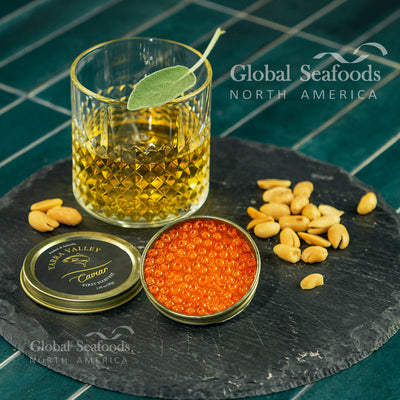🔥 Red Caviar Production: Sustainability, Environmental Impact & Best Choices

Red Caviar Production: Environmental Impact & Sustainable Solutions
Red caviar is a beloved delicacy enjoyed worldwide, known for its rich flavor, vibrant color, and delicate texture. While this luxury seafood is highly sought after, its production raises environmental concerns, particularly regarding overfishing and ecosystem sustainability.
Understanding the impact of caviar harvesting and supporting sustainable alternatives can help preserve wild fish populations while still allowing consumers to enjoy high-quality red caviar.
📌 Looking for sustainably sourced red caviar?
🔗 Explore Global Seafoods’ Red Caviar Collection
1. What is Red Caviar?
Unlike traditional black caviar from sturgeon, red caviar comes from salmon and trout species. It has a bright orange to deep red color, a mildly briny taste, and a bursting texture that makes it a favorite among seafood lovers.
🔹 Popular Types of Red Caviar
✔ Chum Salmon Red Caviar: Known for its large, firm eggs and slightly sweet, delicate flavor.
✔ Pink Salmon Red Caviar: Features smaller eggs with a mild and subtle taste, making it ideal for sushi and canapés.
✔ Coho Salmon Caviar: Medium-sized eggs with a buttery texture and rich flavor.
✔ Trout Red Caviar: Slightly smaller than salmon roe, but with an intense, briny taste perfect for gourmet dishes.
📌 Want to try high-quality Chum Salmon Caviar?
🔗 Buy Chum Salmon Caviar
2. Environmental Impact of Red Caviar Production
While red caviar is a delicacy, its production can negatively impact wild fish populations. Overfishing, habitat destruction, and unsustainable fishing methods have led to declines in certain fish species.
🔹 Key Concerns:
✔ Overfishing: High demand for salmon roe puts pressure on wild fish stocks.
✔ Bycatch: Non-target species may be accidentally caught in fishing nets.
✔ Pollution: Waste from large-scale fish farms can contaminate water sources.
📌 Looking for sustainable alternatives?
🔗 Buy Coho Salmon Caviar
3. Sustainable Red Caviar Farming Practices
To combat environmental damage, many producers have shifted to sustainable aquaculture. Farming salmon and trout under controlled conditions helps reduce pressure on wild fish populations while ensuring consistent quality.
🔹 Benefits of Sustainable Caviar Farming:
✔ Protects Wild Fish Stocks: Reduces the need for large-scale commercial fishing.
✔ Minimizes Waste & Pollution: Modern farming uses recirculating aquaculture systems (RAS) to reduce waste.
✔ Ensures High-Quality Caviar: Controlled environments result in better texture, taste, and safety.
📌 Want to enjoy eco-friendly red caviar?
🔗 Buy Pink Salmon Caviar
4. How to Choose Environmentally Friendly Red Caviar
🔹 Tips for Conscious Consumers
✔ Buy Certified Sustainable Caviar: Look for MSC (Marine Stewardship Council) or ASC (Aquaculture Stewardship Council) certifications.
✔ Support Responsible Brands: Companies like Global Seafoods offer ethically sourced options such as Trout Red Caviar.
✔ Reduce Overconsumption: Enjoying caviar in moderation helps prevent unsustainable demand.
✔ Stay Informed: Learn about sustainable fishing methods and how your seafood choices impact marine ecosystems.
📌 Looking for responsibly harvested salmon caviar?
🔗 Shop Salmon Caviar Collection
5. Health Benefits of Red Caviar
In addition to being a luxury food item, red caviar is packed with nutrients that support overall health.
🔹 Nutritional Benefits:
✔ Rich in Omega-3 Fatty Acids: Supports heart and brain health.
✔ High in Protein: A great source of lean, high-quality protein.
✔ Contains Essential Vitamins & Minerals: Packed with Vitamin B12, Vitamin D, and Selenium.
✔ Low in Calories: A nutritious addition to a balanced diet.
📌 Want to add nutrient-rich caviar to your diet?
🔗 Explore Global Seafoods' Red Caviar Collection
6. How to Enjoy Red Caviar
Red caviar is an incredibly versatile ingredient that can be enjoyed in many ways.
🔹 Best Ways to Serve Red Caviar
🥖 On Toast Points or Blinis – Classic and elegant.
🍣 As a Sushi Topping – Enhances texture and taste.
🥗 In Salads – Adds a gourmet touch.
🍝 With Pasta or Risotto – Creates a luxurious seafood dish.
📌 Looking for more gourmet seafood options?
🔗 Check Out Global Seafoods' Selection
7. Conclusion – Enjoying Red Caviar Responsibly
While red caviar is a prized delicacy, its production must be handled responsibly to protect wild fish populations and marine ecosystems. Sustainable farming offers a viable alternative, ensuring that future generations can continue to enjoy this exquisite seafood.
By making informed choices and supporting ethical brands, you can indulge in red caviar while promoting sustainable seafood practices.
📌 Shop for premium, sustainably sourced red caviar today:
🔗 Explore Global Seafoods' Red Caviar Collection
📺 Watch more seafood insights and recipes on YouTube:
🔗 Global Seafoods YouTube Channel
Also in News

How to Make Sea Bream Sushi With Dry-Aged Tuna & Crab Roll — Step-by-Step With Chef Joshua
A complete guide to making Sea Bream sushi at home, including filleting, curing, slicing, and building a Dry-Aged Tuna & Crab sushi roll. Chef Joshua shares professional tips for restaurant-quality results.

Boiled Crab for Game Night: Everything You Need for a Perfect Seafood Party
Take your game night to the next level with a Boiled crab party. Learn the best recipes, cooking tips, and hosting hacks for a memorable seafood feast.

Boiled Crab for Date Night: A Romantic Guide to the Perfect Seafood Feast
Make your next date night unforgettable with a romantic Boiled crab experience. This guide covers everything you need to know, from ambiance to the best crab varieties.








